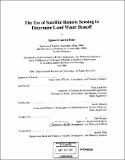| dc.contributor.advisor | Dara Entekhabi and Guido Salvucci. | en_US |
| dc.contributor.author | Patel, Jiganesh Govind, 1977- | en_US |
| dc.contributor.other | Massachusetts Institute of Technology. Dept. of Earth, Atmospheric, and Planetary Sciences. | en_US |
| dc.date.accessioned | 2005-06-02T15:33:05Z | |
| dc.date.available | 2005-06-02T15:33:05Z | |
| dc.date.copyright | 2001 | en_US |
| dc.date.issued | 2001 | en_US |
| dc.identifier.uri | http://hdl.handle.net/1721.1/17516 | |
| dc.description | Thesis (S.M.)--Massachusetts Institute of Technology, Dept. of Earth, Atmospheric, and Planetary Sciences, 2001. | en_US |
| dc.description | Vita. | en_US |
| dc.description | Includes bibliographical references (leaves 30-31). | en_US |
| dc.description.abstract | The purpose of this study is to estimate land water runoff from satellite measurements of net radiation at the top of the atmosphere by invoking columnar atmospheric water and energy balance. Land water runoff is an important parameter in many areas including management of human water use and validation of climate models. Energy measurements taken by satellite are less prone to error than the river discharge measurements required in conventional land water runoff estimates. Mean annual )and water runoff can be determined from net radiation at the top of the atmosphere and the Divergence Bowen Ratio (DBR). The DBR is the ratio of the horizontal flux of internal and potential energy to the horizontal flux of latent heat in the atmosphere. A tropical DBR of -2 was determined from two independent techniques, from a least squares regression relating net radiation with runoff and from the calculation of DBR from local surface humidity. The DBR of -2 corresponds to an approximately one-to-one relationship between net radiation at the top of the atmosphere and land water runoff in the tropics. This DBR also implies that the horizontal divergence of internal and potential energy is equal to twice the horizontal convergence of latent heat through a vertical atmospheric column in the tropics. These simple relationships do not hold in the higher latitudes. Over the tropics, horizontal and vertical transports of energy and moisture are predominantly by nearsteady air motions. Across middle to high latitudes, transient eddy mechanisms become important and the assumptions of the DBR (horizontal temperature homogeneity and steady circulation) break down. | en-US |
| dc.description.statementofresponsibility | by Jiganesh Govind Patel. | en_US |
| dc.format.extent | 48 leaves | en_US |
| dc.format.extent | 1717709 bytes | |
| dc.format.extent | 1717518 bytes | |
| dc.format.mimetype | application/pdf | |
| dc.format.mimetype | application/pdf | |
| dc.language.iso | eng | en_US |
| dc.publisher | Massachusetts Institute of Technology | en_US |
| dc.rights | M.I.T. theses are protected by copyright. They may be viewed from this source for any purpose, but reproduction or distribution in any format is prohibited without written permission. See provided URL for inquiries about permission. | en_US |
| dc.rights.uri | http://dspace.mit.edu/handle/1721.1/7582 | |
| dc.subject | Earth, Atmospheric, and Planetary Sciences. | en_US |
| dc.title | The use of satellite remote sensing to determine land water runoff | en_US |
| dc.type | Thesis | en_US |
| dc.description.degree | S.M. | en_US |
| dc.contributor.department | Massachusetts Institute of Technology. Department of Earth, Atmospheric, and Planetary Sciences | |
| dc.identifier.oclc | 49595625 | en_US |

